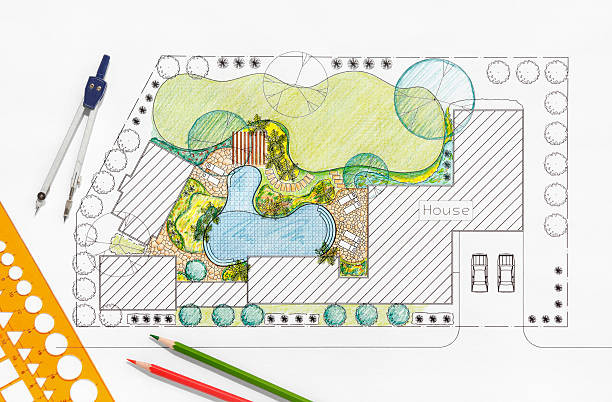As a necessary part of big projects, drafters turn the ideas of engineers and architects into reality. This position requires experimenting and imagination that you must accumulate over time.
So, how to become a drafter? What essential skills do you need to achieve success in the industry?
Let’s dive into this article to find some valuable facts related to this topic!
What Is A Drafter?
A drafter is a person who takes designs from the engineer and architect and uses software programs to convert them into technical drawings and plans for machines and buildings.
In other words, draftsmen translate the design ideas into visual forms to display how the project may look. They may specialize in many fields, including mechanics, architecture, or electricity.
Specifically, the schematics they create work well in the Building Information Modeling systems (BIM) and Product Data Management systems (PDM), allowing them to print, view, or program them directly and smoothly.
These schematics produce digital models of buildings and machines.
What does a draftsman do?
Drafters create technical drawings from rough sketches and specifications provided by engineers and architects. Their job duties may include:
- Design and develop plans using computer-aided design and drafting software.
- Create effective product designs using their engineering and manufacturing knowledge
- Add structural features to architectural plans
- Come up with multiple versions of designs for engineers and architects to review.
- Specify materials, dimensions, and procedures for products or building projects
How to become a Drafter
So, what are the best ways to learn to become a drafter? Let’s see!

1. Complete high school education
While you’re still in high school, you should enroll in technical classes to create some stepping – stones to your career as a drafter.
It’s best to choose math, science, and computer courses as you will need to perform accurate calculations and work with complex software. These courses can help you get familiar with your chosen professional path.
You can consider the following types of courses:
- Math classes including algebra, calculus, geometry, and statistics
- Art classes (like drawing)
- Computer classes in Computer-Aided Drafting and Design
- Shop classes (to understand how machines work)
2. Choose a specification
Many professional drafters specialize in particular types of projects. As a result, you should consider the types that you’re passionate about or determine if you want to work on general drafting jobs. This way, you can make better course choices during your degree program.
3. Earn an associate degree
After graduating from high school and choosing your specification, you can enroll in a two-year drafting program at a technical school or community college. These classes should teach you theoretical and practical skills while providing hands-on drafting experience.
Concentrate on courses that will help you develop in your chosen drafting specialty. As you work toward your associate’s degree in drafting, you can choose among the following classes:
- Blueprint reading
- Basic, architectural, and landscape drafting
- Computer-aided drafting and design
- Measuring and calculating
- Manufacturing mathematics
- Tolerancing
4. Gain experience
You can obtain expertise in drafting in various ways. An excellent approach to getting drafting experience is working as an assistant or apprentice for a professional drafter.
You can volunteer in your neighborhood to help others with repairs or construction projects. Ask your area businesses, organizations, and groups to see if they require assistance with construction or maintenance.
They may need you to design and create sets for plays or clean a large machine. These activities can provide practical experience with building plans and machine operation.
Below are some examples of ways to get experience while also assisting others:
- Habitat for Humanity program
- International projects with the UN’s Global Compact Network
- Disaster relief projects

Like other occupations in the field, you can work as an intern to obtain experience in a professional setting. You can intern while you’re still in college or after you’ve graduated.
Make contact with local architects, building and manufacturing firms, and technological companies. Ask whether one of their departments is searching for a drafting intern. Sending letters of intent and a resume is also a good idea.
Interning with drafters or organizations that use drafters can complement your coursework and provide you with practical experience. This method surely can help you land a career later.
If possible, you should search for the name of specific supervisors at those companies. Inquire with them if they know somebody who could oversee you as a drafter for their firm.
5. Find a job
Once you’ve finished your internship, you can start looking for draft jobs. Don’t forget to create a professional resume that displays your schooling and other qualifications to impress potential employers.
You should look for possibilities to gain practical knowledge. Thus, apply for jobs such as doing construction or manufacturing work. You could also work with computers or electrics in a factory.
These positions can give you hands-on experience that translates into more complex and detailed plans, making you stand out from other drafting applicants on the job market.
6. Become certified
It’s best if you can earn a professional certification from reputable drafting organizations. This title can demonstrate to your employers that you are well-versed in the field. The draftsman certification examinations assess your knowledge of geometric designs, drawing, and drafting fundamentals.
7. Consider a bachelor’s degree
At this stage, you can return to school to further your education and boost your draftsman profession. If you already have an associate’s degree, you might transfer your credits and finish your bachelor’s degree in four years, which can help you advance in your career and earn more money.
Although most four-year universities and colleges do not offer drafting degrees, many offer courses that you can use to supplement your drafting training.
Transfer to a university or college to get additional specialized training to complement your drafting degree and make you more appealing to companies.
Choose classes in architecture, engineering, and mathematics. These courses can assist you in better comprehending and translating the requirements and wants of engineers and engineers into your blueprints.
If there aren’t any colleges or universities in your area or you need a flexible schedule, you can consider an online associate’s degree program.
8. Take the drafting certificate test
Obtaining certification as a professional drafter can help you to maximize your education and work experience. The American Design Drafting Association, for example, offers certification programs for drafters.
Many drafting knowledge such as drawing, tolerancing, geometric designs, and other basic techniques are all tested on the certification exams.
Although certification isn’t compulsory, it might help you demonstrate your expertise and proficiency in your profession.
It’s also important to note that employers may ask for some professional experience if you do not have a certification exam.

9. Attend continuing education classes
Many certifications are valid for three years, meaning you must renew regularly.
You can obtain recertification by passing exams that have been updated to reflect new professional advancements.
Maintain your professional knowledge by enrolling in continuing education classes throughout your career.
These classes help you pass the renewal certification exam, making you stand out from the crowd and winning the attention of your current employer.
10. Join professional organizations
Once you have gained at least five years of professional experience, you should join a national or local drafting organization.
As a part of these professional organizations, you can connect with other drafters who can introduce you to some continuing education seminars or new job opportunities that you might be interested in.
What are the different types of draftsmen?
It’s important to know that working as a drafter means you have multiple options in this industry. Depending on the specialization, some types of drafters include:
- Aeronautical draftsman: Aeronautical drafters take engineering drawings, outline specifications, and prepare plans for manufacturing missiles, aircraft, and other relevant products.
- Architectural draftsman: Architectural drafters outline the buildings’ structure features in construction projects. Typically, they focus on a specific type of building (residential or commercial) or different materials, like steel, wood, or reinforced concrete.
- Civil draftsman: They are responsible for preparing topographic maps for civil engineering and building projects.
- Electrical draftsman: Electrical drafters create wiring diagrams for construction workers to repair and install electrical equipment and wiring. They often work for residential or commercial buildings, power stations, or electrical distribution systems.
- Mechanical draftsman: Mechanical drafters usually design layouts for various automated tools and machinery. They include details like dimensions and fastening methods for assembling.
- Pipeline draftsman: A pipeline drafter prepares layouts for piping design systems that are applicable for refineries, construction, chemical plants, and operation of gas and oil fields.
What Skills Do You Need?
Like other occupations, a drafter also needs to train and accumulate particular skills and technical knowledge. Below are some hints for you:
- Pay attention to every detail: When converting plants, you must give care to the smallest details so that you can fulfill the requirements.
- Creativity: You should employ creative thinking to translate ideas and plans into technical drawings.
- Experience with CAD software: Technical skills and database technologies assist draftsmen in creating drafts. As a result, you should have a basic understanding of CAD software and building information modeling (BIM).
- Communication skills: Because draftsmen work closely with architects and engineers, you must have good communication skills to verify that designs are accurate.
- Math skills: You may use math skills to determine some factors on technical drawings, such as weight, angles, and costs.
- Time management: You must be able to work quickly and efficiently to meet tight deadlines and deliver projects on time.
Frequently Asked Questions
How Long Does It Take To Become a Drafter?
Typically, a drafter takes two years to earn a diploma or associate’s degree from a community college or technical school. They may continue studying at university for four more years, but it’s optional.
How Much Can A Drafter Earn?
You should now wonder about the salary! What is the average salary for a draftsman?
The average annual pay of drafters is $68,423 in the United States. Still, salary levels may differ depending on location, experience, and company.
In some specialties, the US Bureau of Labor Statistics predicts a 4% decline in job opportunities for drafters from 2019 to 2029.
Positions in manufacturing and engineering are expected to decline as the application of BIM and BIM technologies grows, according to the BLS.
Local industry demands may also impact a draftsman’s job chances. Specifically, industrial companies require more mechanical drafters.
What are some related alternative careers?
Architects, electromechanical technicians, and civil engineering technicians are some similar design jobs. These positions also contribute to the infrastructure planning stages of a project. Like drafters, they employ specific skills, such as math and creative problem-solving.
Where does a draftsman work?
A draftsman works in a general office context. Some may travel to construction sites to meet engineers and architects and discuss ongoing projects.
Drafters can work in many manufacturing businesses, including:
- Construction
- Architectural and engineering
- Wholesale trade
Does drafting require math?
Yes, you may employ basic mathematics, algebra, geometry, trigonometry, and Cartesian math in drafting college and workplace.
Remember that you will design highly technical drawings in your later positions.
At that moment, a strong math foundation will guarantee that your designs are precise, usable, and proportionally right.
Conclusion
This article has just provided you with an in-depth guide on how to become a drafter. If you’ve read this far, we hope you can now feel satisfied with our knowledge and experience in the industry.
It’s important to note that you may not attend continuing education classes if you can’t arrange the time, as they’re optional. Alternatively, you can keep studying and educate yourself with various sources on the internet. Good luck!
